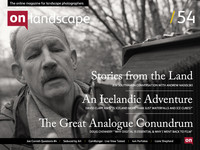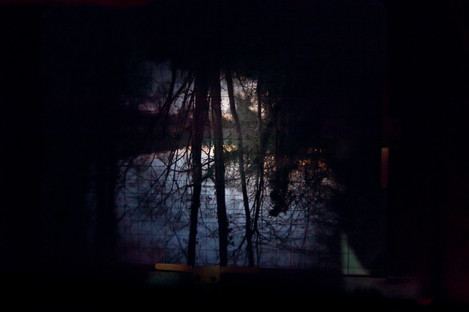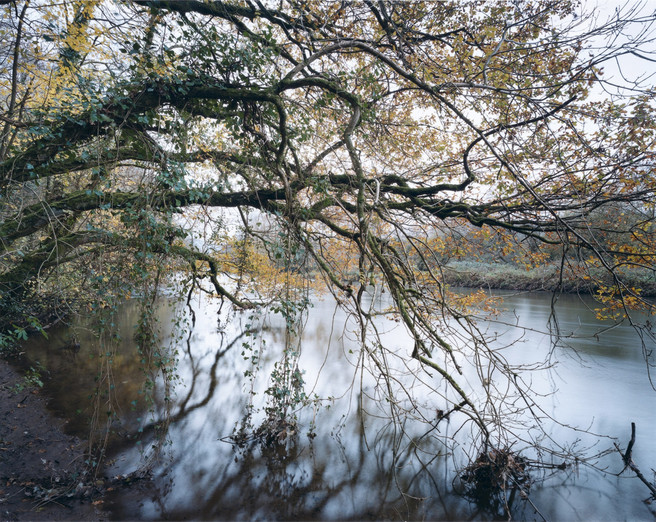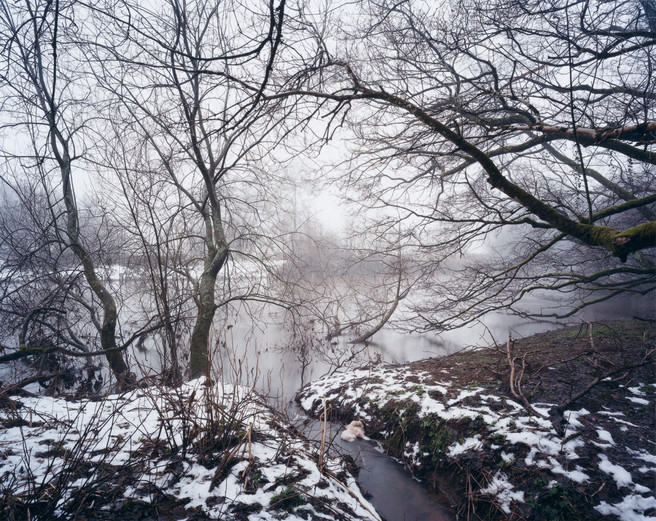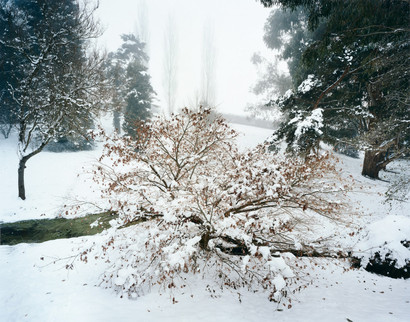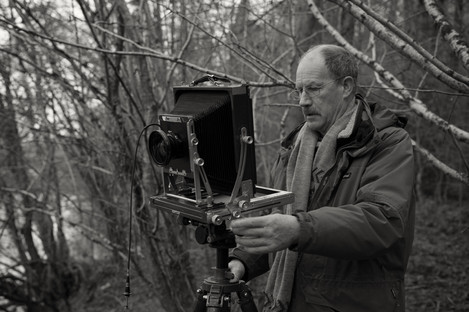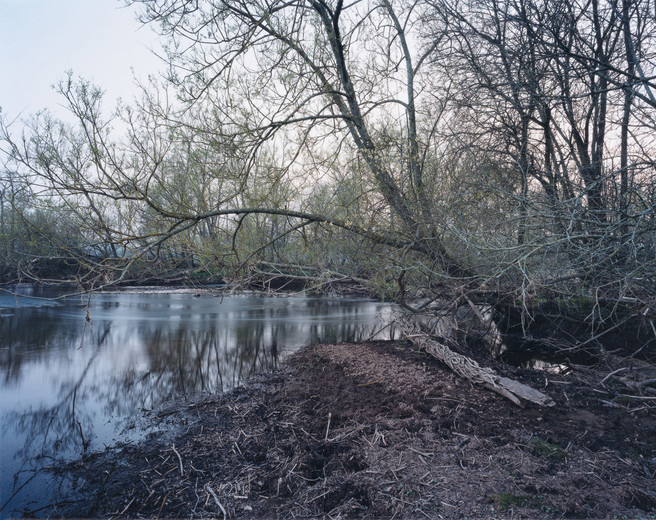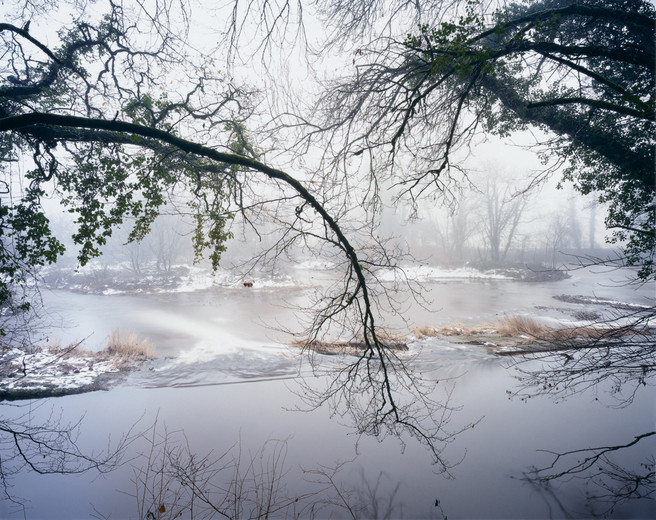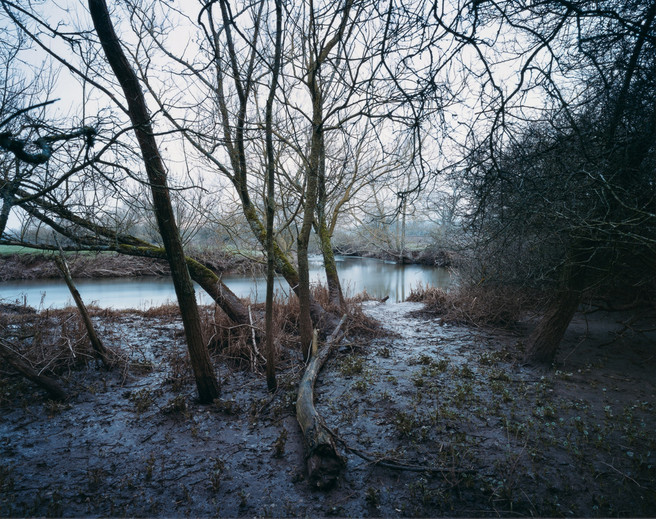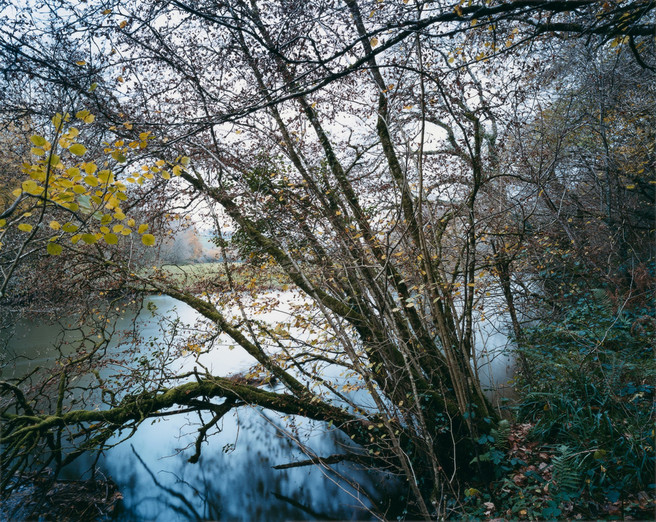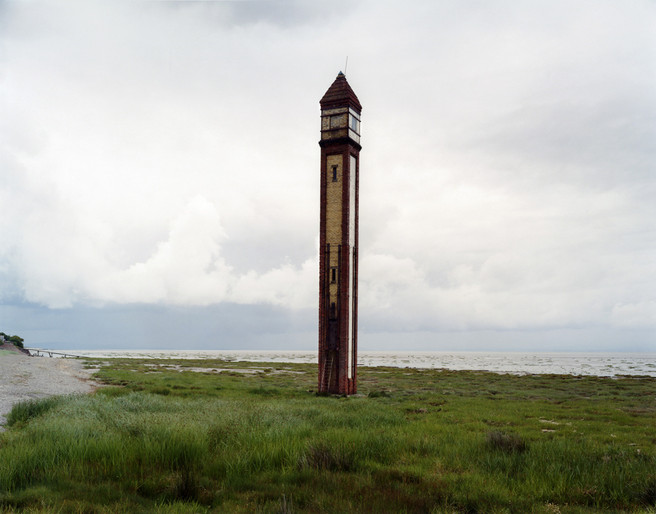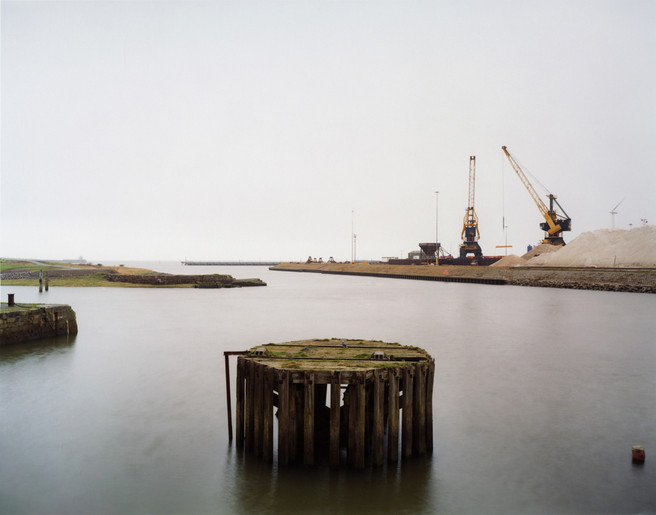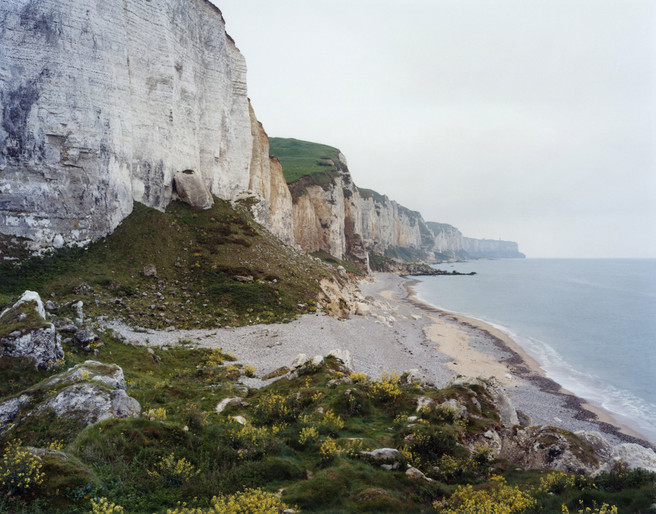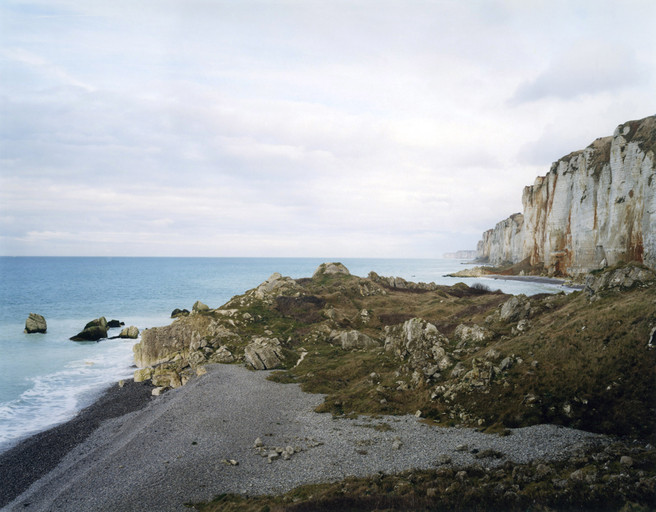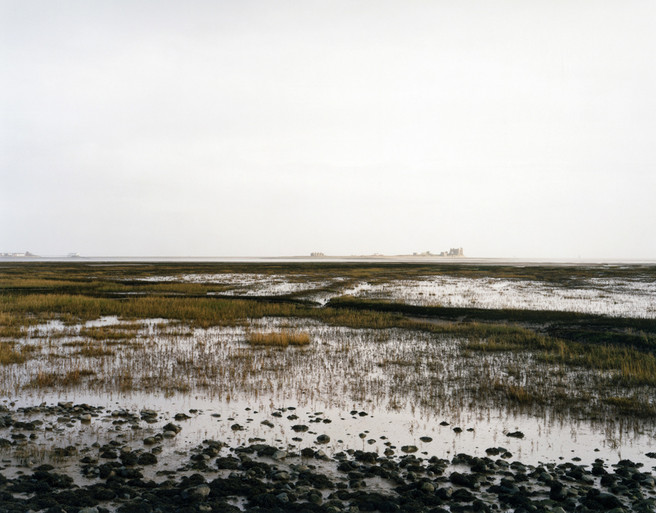Jem Southam in conversation with Andrew Nadolski

Andrew Nadolski
Andrew Nadolski is a professional designer and photographer based in Exeter. His series 'The End of the Land' has been exhibited in museums and art galleries across England and has been published as a book by Headon House.

Jem Southam
Jem Southam is critically regarded as one of the most important British photographers of the last twenty five years. Working with a 10x8 view camera and colour negative film, his patient pursuit of his art seems at odds with the frenetic pace of life in the 21st Century.
He predominantly works in South West of England, often returning to the same location time and time again to record subtle variations in the landscape, how it changes during the seasons and exploring the balance between nature and mans intervention upon it.
His photographs combine patient observation of the land with personal, cultural and literary references. Appreciating his work requires patience of the viewer, but this patience is hugely rewarded as layer upon layer of thought is revealed in his often complex photographs.
His work is included in many important collections including Rijksmuseum, Museum Folkwang, and the Yale Centre for British Art. He has been the subject of numerous solo shows including Tate St. Ives in 2004 and The Victoria & Albert Museum in 2006. He has exhibited widely in Europe, the US and the United Kingdom.
He is represented by the Robert Mann Gallery, New York and James Hyman Gallery, London and is currently Professor of Photography at the University of Plymouth.
A bit of background...
I have known Jem Southam since 1985, when he started lecturing at Exeter College of Art where I was in my second year as a photography and design student. Looking back, I realise I was privileged to study during what now seems was a ‘golden age’ of photography education. By my recollection there were only nine students in my year in that particular department and we were required to be in the college from 9.00am - 6.00pm unless we were out shooting. Most evenings were spent in the nearest pub or wine bar, often joined by our lecturers, where photography debates would continue well into the night - we truly lived and breathed our ‘art’.
Alongside Jem Southam we were also privileged to have Paul Graham (now an ‘art photography’ superstar) as a regular visiting lecturer. But in a sense lecturer is the wrong word to use as ‘lecturing’ implies a group of students sitting passively in a lecture theatre being talked to by some intellectual figure. Because of how our course was structured we would simply go and talk to Jem, Paul or whoever at any stage of the day, often thrusting still damp contact sheets in front of them for a quick appraisal. We were also lucky to have a technician, Dave Smaldon, who was an accomplished photographer in his own right. In fact my first exhibition was a joint one with Dave at Plymouth Arts Centre in 1989.
Before begining his teaching at Exeter, Jem had just finished a series of pictures called ‘Paintings of the West of Cornwall’ and he was starting work on his seminal book ‘The Red River’. When I think back now, it is amazing that for a heady two years I was taught photography by two people, who along with Martin Parr, would be later seen as leading figures in the emergence of the new wave of British colour photography.
Since I left college I have kept in touch with Jem, and we periodically meet up to discuss our own work and photography in general. Jem is a quiet, modest and deeply thoughtful man whose nature and intellect is reflected in his work. I was privileged to see early contact sheets from the series that would become ‘The River - Winter’ and remember being overwhelmed by them. It is a real delight to see them collected together in such a stunning book, which I think will be regarded as one of his most important works.
In January, despite the fact that he was suffering from a heavy cold, Jem and I walked a short stretch of the River Exe at Bickleigh and he showed me where a number of his pictures had been taken. As the light faded he decided to set up his 10x8 to make a picture and I was able to take a few photographs of him at work.
On the way back to the car we discussed the fact that a lot of writing about photographers and their work is not surprisingly, done by critics and that sometimes what we are reading tells us more about what the critic thinks than what the artist thought when they were actually doing their work. What we both agreed was fascinating, was trying to explore where an artist’s initial idea came from and how it can develop during the period of photography. With this in mind, Jem kindly agreed to answer some questions about his photography and importantly the origins behind some of his work.
Jem Southam
in conversation with Andrew Nadolski
Jem, you work in stories or themes - can you tell me how ‘The River - Winter’ evolved? Did it stem from one single picture or did the full idea develop from a number of images?
As I am getting older it is getting more and more fun tracking the evolution of a work and realising how complex the genesis of a body of photographs actually can be. In this case it is, on the surface, more straightforward than some, as I can trace the idea back to two simple events.
The first was an accidental meeting around 17-18 years ago with a colleague in our newly formed faculty. We had a discussion lasting no more than 20 minutes, the result of which was a seed planted in my imagination, which in 2008 led me to start photographing along the Exe river. She related to me a project she had initiated asking primary schoolchildren to draw a river. By comparing the results across the years she hoped to see if she could identify the stages at which their minds developments mapped the increasing sophistication of their conceptual understanding, as shown in the drawings. I was very intrigued by this idea and many years later asked a small group of kids in our street to each draw me a picture of a river on A4 paper. The results are astonishingly interesting and suggested a couple of ideas worth following. The first was that fully understanding what a river is might be well beyond our human abilities to comprehend, (Such notions of complexity have been behind much of my work over the last 15 or so years, in the rockfalls for example.) The second idea was that there is no place in our brain in which the answer to the question ‘What is a river?’ is simply lodged. Memory and understanding are processes, the act of drawing provokes and stimulates the mind into actions of articulation, through whatever means we happen to use. So the idea behind the project was to try to define what a river is by the act of photographing one. This scale of this river project is potentially enormous and I have been working on it ever since. There are already perhaps 60 resolved pictures and I have only just got going.
Taddiford Brook, Exeter, 26 December 2010 from the book ‘The River - Winter’
The second event was a huge snowstorm just before Christmas 2010. My wife and I woke in the early morning intrigued, as one is, by the sound of snow falling outside. We got up and went out and had a most wonderful walk for a couple of hours in the heavily falling snow, right through till dawn. We walked from our house to the university grounds which are near us and which I have never had any interest in photographing. There are a series of linked ponds at one point in a sharp valley and for once I wanted immediately to go and get my camera and make some pictures, which is what I did after breakfast.
(What is important to state here is that in Exeter we rarely get much snow and this fall turned out to be the heaviest for at least 40 years.)
I had been making my pictures along the River Exe for 2-3 years by now and that autumn had had a particularly good run. As I took the first snow pictures I realised the potential of this body of work following the course of a single winter and determined then and there to continue, which is what happened.
So those are the immediate points of departure but as one delves into the imaginative background to a work things become much richer and much more complex. I had for instance already made a piece of work about a river in the 1980’s. ‘The Red River’ was made over a 5 year period following a small tinning-stream in the west of Cornwall. I have continued to photograph along that stream and had never thought of making another river work – they are by their nature rather prolonged and exhausting! But behind this current work lies that earlier study.
Sorry a long answer.
The photographs in the book play wonderful games with our subconscious. They feel steeped in ‘history’, drawing on an almost medieval notion of the dark, deep winter. They feel much more ‘of Europe’ than say North America. Do you feel this is because of our almost ‘inherited memory’ drawn from paintings and literature?
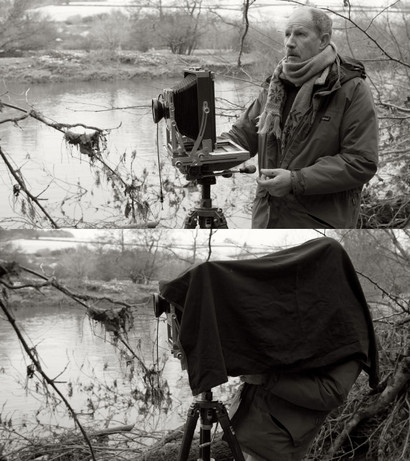 The main theme though behind the book is the one picked up and developed so well by Richard Hamblyn in the essay, and that is how ‘Winter’ is embedded in the imagination and culture of those of us who have lived our lives across north western Europe.
The main theme though behind the book is the one picked up and developed so well by Richard Hamblyn in the essay, and that is how ‘Winter’ is embedded in the imagination and culture of those of us who have lived our lives across north western Europe.
It is how since the last ice age our world view has been shaped by the experiences of winter here, which are distinct from those who live say in Scandinavia, or across the Mediterranean. How in painting, in literature and in many other cultural manifestations did the history of those last 14,000 winters engrave itself in our minds, and yet each and every winter is unique.
I could in theory go and spend a winter in Sweden and select a place to work and make a series following the passage of a season there, in fact I would love to do just that. But the pictures would not be informed by a history of the generations living those long dark winters and as a result I think it would miss something, so my pictures come from my personal background and my own lifes living, and I believe I make better work that way.
There is a dark beauty to the images, the very subdued colour palette and the steely blue shades in some of the images create an image of coldness that is less obvious, yet more successful than say images of pristine snow and ice. You have worked hard to so successfully portray the notion of a season.
The second is that I am of that generation of photographers who set out to explore the potential of still colour photography. We wished, for a number of reasons, to work against, or at least question, some of the accepted conventions of colour photography, and I certainly realised that there was much ground for me to explore. As the years have passed and as the technological evolution of film continued this has grown as a personal preoccupation, to a point now where it is one of my primary interests.
Like the photographs in ‘The Painter’s Pool’ you have created some wonderfully complex compositions, which can’t easily be deconstructed with simple formula. You are making images from what must initially seem quite chaotic subject matter with branches very close to your camera lens. How do you begin the picture making process in these conditions?
‘The Painter’s Pool’ came from a conversation with a colleague at the art school I work in. He was a painter who had worked in the same small piece of woodland just outside Exeter for decades. Over the table in our canteen one day I talked to him about what he was trying to do with his paintings and he put it very straightforwardly – ‘How does someone who draws or paints deal with the extraordinary visual complexities presented when standing in the canopy of a wood? How can one possibly make a series of marks on the surface of a piece of paper when confronted say by the tens of thousands of twigs and leaves present, as one stands and contemplates such a view?’
Not having a background in painting I had never contemplated these matters before and I decided to see what happened when I approached photographing in the wood, asking the same sort of questions, but with a large format plate camera. The series of pictures grew partly out of that motivation and I have continued to be fascinated by the challenges of making pictures in similar conditions. I wish to make pictures that are complex and demand a patient attention. When photographing I am also always conscious of how I wish the photographs to work at two different scales. They need to work both as a 10”x 8” contact print and as an exhibition print, which I usually make to about 36” x 45”.
I imagine shooting some of the images in the book presented a unique set of challenges both technical and logistic. You seem to be setting up your bulky 10x8 camera and tripod in the middle of dense shrubbery and on the soft mud of a river bank. You are working in the shadows looking out. The exposures must have been very long?
One thing I imagine we all share – and I am thinking now about all of those reading this who share the sheer joy of walking out into the landscapes we wish to photograph – is the physical and psychological pleasure of doing so. I don’t understand why everyone is not a landscape photographer! How much more fun, how much richer can life get, than when we are all in various ways and in our various sites out walking and working with our cameras?
I have my way of doing this, which in this work involves a large camera, and yes sometimes difficult conditions, but I also make work with a 6x7 camera – on holidays for instance when I am forbidden to take my large cameras – and then I just plod along a beach or cliff working away on roll film.
To get back to the final part of the question – the exposures are surprisingly shorter than I expect, usually around 2-20 seconds. In the past I was working with Kodak Portra T. The tungsten emulsion allowed us to use longer exposures. The daylight film VPS went all over the place with cross curves etc with exposures over a few seconds. The tungsten emulsion was 100 ASA, which I exposed at 50 ASA, and I also used a compensation filter which reduced things even further. So stopping down to f45, my exposures were often many minutes long. ‘The Painter’s Pool’ exposures varied between 2 to 20 minutes for instance.
Today it has never been easier to take pictures with auto exposure and programme modes in digital cameras and the ability to ‘fiddle’ and ‘tinker’ with images in Photoshop; yet you choose to still work predominantly with a cumbersome 10x8 camera and tripod often necessitating the use of a stepladder.
Is it because of the experience of seeing the world inverted on a ground-glass screen? The whole picture making process must force a much more contemplative approach.
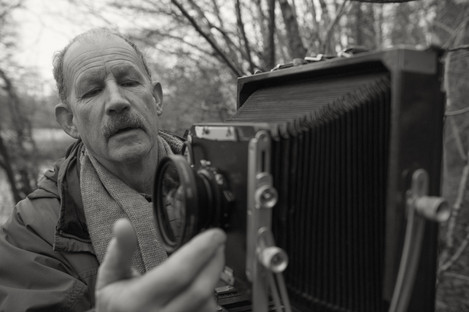 Absolutely. Two of the reasons I keep working with 10x8 are:
Absolutely. Two of the reasons I keep working with 10x8 are:
1) because it is so difficult
2) because looking through that screen at the inverted image, cloth over the head, often balancing on a ladder, is an enthralling thing to do.
If it is too easy to make pictures it is I think less enjoyable. Surely this is the same with all endeavours - as humans we want to be challenged and to work through problems, and the tougher they get the more they demand of us and when we work though them the greater the reward. If it was easy to make great pictures how many of us would bother?
You have told me in the past that you can go to the trouble of setting up the 10x8 camera and if you don’t feel the image is going to work you don’t take a picture. Also you have said you only ever take one picture from a particular position; that must take immense self-discipline. Do you feel working with expensive sheet film helps engender this approach?
Well I shudder when I think of the cost of what I am doing. I dropped off some film at the lab I use this week and the guy who processes said ‘Blimey that’s nearly a thousand pounds of film.’ That shook me up, made me wonder how long I can keep going. So price is one factor but it is not the most significant. For if one were working and looking through the camera and saying to oneself ‘I can’t really afford to take this picture’, then that would be a hopeless situation.
What is a more critical factor is the consideration ‘What is the potential significance of this picture? Is it really going to add something to what I am trying to do?’ I spent a weekend a few years ago with Martin Parr, who invited me along on a weekend workshop he was giving on the Isle of Wight. It was a really enjoyable and stimulating few days and during the course of it those taking part, who were exclusively working with digital cameras made I calculated somewhere around 20,000 exposures between them. I kept asking them ‘ But what are you going to do with all the pictures?’, and their reply was usually ‘Archive them.’ I went away from the weekend saying to myself that I must really only make an exposure when I felt something.
When I was in my twenties I never imagined I would be able to work in 10x8, it was just so expensive. I thought it was only really an option for American photographers. But now I have been doing it since about 1995 and it is the most satisfying way of making pictures I have ever experienced. But I think we are the last generation who will ever have the pleasure of working with colour film at this scale.
A lot of landscape photographers race around chasing a sunset in ‘classic locations’. It amuses me to see so many websites and book titles along the lines of ‘chasing the light’ almost as if landscape photography was akin to hunting and that we are ‘bagging’ images as ‘trophies’ - ‘image making’ seems to have changed to ‘image capture’. This would seem to be the total antithesis of how you work.
Maybe there is something in what you say, but it is my belief that the particular relationships between the endlessly varied permutations of light and the nature of ‘image capture’ – be it analogue or digital – are at the crux of good pictures. So I am as concerned about this chase as anyone else. What I also believe though is that standing still and paying close attention will reveal as many riches as charging around the globe.
One of the issues I have with much of the current work I see in galleries and books though, is that it is made within a rather limited set of conditions. I am as guilty of this as anyone. There are particular conditions I like to photograph in, in which I may, if fortunate, make a good picture. In fact it has got to a point within my family where they look through the window of house or car and say to one another – “Photographers light!’ - and then they all pointedly look at me because they know I will start getting twitchy and grumpy because for whatever reason I cannot get out with the camera.
So recently I have been trying to break out of this condition and set out to make photographs when I would not normally do so, and I find it very hard but I am trying.
It almost seems amusing to say this but ‘The River – Winter’ seems to have been quite a prolific period for you.
I remember you showing me some of the first contact prints and being stunned by them. How early on did you feel you were ‘onto something’, as image and concept sit so extraordinarily well together with this work.
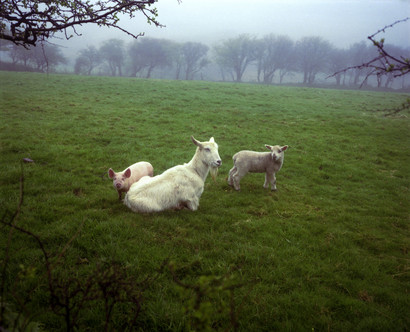
The Pig, the Lamb and the Goat from the series ‘The Red River’
You can read more about this intriguing image and Southam’s
thoughts on it on the
Guardian’s website
To put this question into some sort of context, and bearing in mind the comments above about how many pictures I take, I find that in an average year I may take 40-50 pictures with the large camera. Sometimes it is less (in 1996 I exposed about 10 sheets of film, that’s about all I did that year), sometimes it is a bit more. And on top of that I find that there are seasons or periods when I photograph more than others, so I do not often photograph between May and September even though this is when I have most free time. This is partly to do with light conditions and partly problems with excessive amounts of foliage – modern negative films responses to greens are a great problem to me, I just do not like them and have little interest in making pictures I don’t like.
With this book I had not taken any negatives since March/early April and began again in October 2010. Between October and mid-December I had a good patch, and on 23 December the snow fell. It fell like it had never fallen before in all my time in Devon, and I found a site near my home, that I could walk to, and photographed the snow for a week. It was during this week that I realised the possibility of following a winter, and I just kept going till the solstice in March. I shot more negatives in that period than I have ever shot before or since.
Your images go far beyond the sublime and beyond the notion of epic photography, yet in doing so they tell us far more about our relationship with the landscape around us.
I will be really interested in seeing how the images are received in North America. Your approach shows such restraint - it is light years away from the Ansel Adams ‘school of epic photography’ but to my mind they are so much more powerful because of their subtlety.
One matter which I have come across several times is one of scale. One side of American psyche seems fixed on notions of extent, of vastness, and ties such scale to significance. So one time I had a review of my Rockfall pictures by an American writer who said that in the USA, landslides were BIG, and that my landslides were puny by comparison, and that the pictures were also therefore somehow inconsequential. Wonderful stuff.
A more interesting issue regarding scale though revealed itself during a talk in Boston where I was talking about how I walk about where I am photographing. Several people picked up on this and asked ‘So are you saying you WALK about with your cameras?’ and when I replied in the affirmative they sort of shook their heads and said ‘Astonishing.’
We have looked across the ‘Pond’ for decades wondering at the work made by American photographers and are overawed by it, and have intentionally or not been over-influenced by it. What we are in danger of forgetting is that we have so much richer traditions here then they have over there. Our connections to the landscape here go back generation after generation, the cultural histories of Europe are so much more extensive and we can draw on all of this when we make pictures.
Because the USA has a much more developed interest in photography than we do in Europe, there is much more extensive museum and market activity around photography which draws our attention, but I increasingly think I want to place my work in European contexts because people will relate to it more effectively.
Over the years you have been commissioned to work in a number of differing locations, away from a more familiar landscapes - I am thinking of your Lowry commission and your work in Normandy. How do you approach working in unfamiliar locations? Do you feel a need to connect with the landscape, to gain some understanding of it, rather than just ‘diving in’?
Because I had already been working on photographing rockfalls for 10 or so years I had few new visual problems to work through and could get on straight away. The Normandy cliffs are really wonderful and access is much more straightforward than in England and I plan to continue working there for a while longer. The original commission paid for me to make 4 visits over 2005/6 and I have continued to go back but it has been a while now.
However, I have plans for a book which will pull all the 20 years of rockfall work together, and the Normandy work is not yet resolved, nor some of the English series, so I hope to focus on all that soon.
This wet weather makes it a bit more problematic though as the cliffs are particularly dangerous at the moment.
In England and much of Europe it is very hard to find areas of the landscape that haven¹t been altered at some stage by agriculture and or industry. Are you more interested in this notion of change and history than say trying to create make-believe images of a bucolic landscape or imagined wilderness?
When I look back over the various bodies of work I have made, over the years and consider where they have been made it is clear that I have a fascination with locations where the processes that transform landscape are very evident. Several of them are sites of large scale industrial activity – frequently mining or extraction processes; tin-mining through ‘The Red River’, manganese mining at Upton Pyne in Devon, the china clay industries of St Austell and coal, iron and smelting along the Cumbria coast. What interests me here are that landscapes which are formed by these processes are completely unplanned – they are the result of the technologies required to do the particular actions required. I find these places much more interesting than planned landscapes, indeed the worst anyone could ask me to do would be to photograph a highly planned and controlled environment, I could do it but I would be overly influenced in my compositional decision-making by the plans of others.
Bucolic landscapes or imagined wilderness would be fine but I am not aware of any such places near Exeter! I have tried Dartmoor but it is a particularly challenging place to make pictures. In all the years of teaching in Devon I have rarely seen any students successfully tackling the moors of Dartmoor.
Can you tell me which photographers have inspired you over the years. I know we both share a deep fascination with the work of the Bechers. How important were they, and say the New Topographers in your early days as a photographer?
When a student in London in the late 1960’s I saw just two exhibitions of photography. One by Bill Brandt and one by Paul Strand, and they were two of my earliest influences. Of the two, Paul Strand still really commands my interest. Then in the mid-1970’s it was the Bechers as you say. The clarity, the discipline, the ambition, the relentless work ethic, the intellectual strength, and the overall coherence of a lifetimes work is just awesome. Then it was the New Topographic movement and all involved in that, and after that American colour photographers, quickly followed by my own British generations response to working in colour – all the usual suspects in fact. But over the past decade I think I have been more drawn to classic 19th century photographers who dealt with landscape and in particular Eugene Curvelier. Much of what I try to do compositionally he did much better 130 years ago!
You have begun to make forays into the world of digital printing and negative scanning. How are you finding this process compared to conventional darkroom work?
Recently for instance I began to get some very mild fogging down one side of my negatives. It was so slight I did not notice it when inspecting the negatives and it wasn’t until later when I contacted the pictures I began to notice, and then it took longer to work out the cause during which time I was still using the darkslide which I eventually found out was causing the problem. So I had three or four really important pictures which I could never print conventionally. Retouching digitally completely removed the fogging. Brilliant.
So that’s one issue, the other is that recently the quality of analogue printing paper has plummeted. Kodak have also stopped marketing sheet papers. The modern Fuji Crystal Archive might make for good prints through a minilab but it is absolutely ghastly in a darkroom – in my view.
So again digital printing comes into play. The choice of papers, the quality of the papers, the flexibility of the processes – it is obvious even to me that this is where my future lies.
However, I have two further reservations about completely switching to digital printing. The first is that I have found that I still need to make a contact print or prints before I begin to interpret a picture digitally, to give some reference points for colour balance, tonal qualities and so forth. I still do make exhibition prints using analogue processes as I still find that there is something within an analogue print which I just cannot yet reproduce using digital printing.
Examples of this are a set of prints I did a while ago which were taken in England on very soft wintery days. The subtleties of the tones in the skies which were of the minutest shifts of tone and colour seemed beyond the reach of the technologies I was using, and I was working with highly skilled people and technologies. Until that can be sorted I will continue to try to print using analogue processes.
A final factor is cost, and also time, which always have to be considered. Digital printing for instance is much slower than analogue. Last summer I made my first ink-jet prints at the university using our equipment and was delighted with the results, bearing in mind I had done them myself (with a huge amount of support from colleagues and technicians), but it took me about a month to print 12 pictures.
‘The River - Winter’ is published by MACK. You can order copies from Beyond Words
More on Jem Southam
Mike Chisholm writes about Below South Crofty Image
Jem Southam's talk at Meeting of Mind Conference
- River Exe at Bickleigh, 22 November 2010 from the book ‘The River – Winter’
- Taddiford Brook, Exeter, 26 December 2010 from the book ‘The River – Winter’
- River Culm at Silverton Mill, 22 January 2011 from the book ‘The River – Winter’
- River Exe near Brampford Speke, 28 March 2011 from the book ‘The River – Winter’
- River Exe at Bickleigh, 22 November 2010 from the book ‘The River – Winter’
- River Exe at Bickleigh, 29 December 2010 from the book ‘The River – Winter’
- River Exe at Bickleigh, 29 December 2010 from the book ‘The River – Winter’
- Peil Island from Walney Island, Morecombe Bay from the series ‘Clouds descending’
- The Pig, the Lamb and the Goat from the series ‘The Red River’ You can read more about this intriguing image and Southam’s thoughts on it on the Guardian’s website
- Senneville-sur-Fecamp (looking north) 2007 from the series ‘Rockfalls, Normandy’
- Senneville-sur-Fecamp (looking south) 2008 from the series ‘Rockfalls, Normandy’
- Workington Harbour from the series ‘Clouds descending’
- Lighthouse, Rampside, Morecombe Bay from the series ‘Clouds descending’

